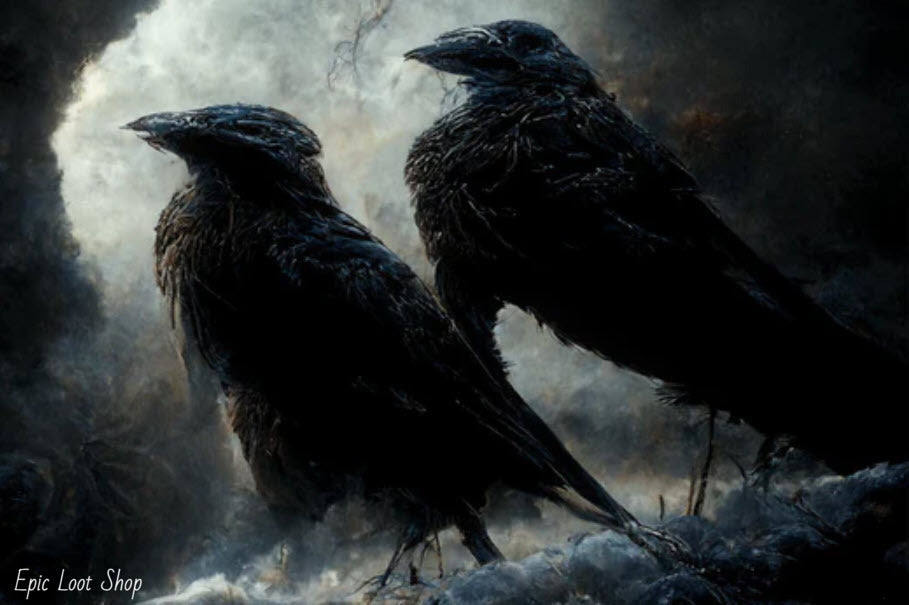Odin's Ravens - Huginn And Muninn
The two ravens, Huginn (thought) and Muninn (memory or mind), are Odin's eyes and ears in the world, who bring him information from all over Midgard. They are said to be able to fly through the air without flapping their wings, a supernatural ability that is undoubtedly associated with Odin's own magic. Odin sends them out at dawn every day to fly around the world to collect information for him, and they return at dusk just in time to perch on his shoulders as he contemplates his day. The story of Odin's ravens is one of the more interesting tales in Norse mythology; it is a tale of loyalty and intelligence, of cunning and deception.
In the beginning of time, Odin sent both birds out from the hall of Valhalla to gather information on what was happening in Midgard, the mortal world. They traveled through the sky and over Earth every day, and at night they would return to present Odin with their reports: Huginn telling Odin what he had seen and heard during the day, while Muninn would tell him what they had observed the previous days.
The information was always relevant. Huginn reported back to Odin everything that he saw or heard during his travels, including what he saw in homes, businesses, and any other places where people were gathered. He also reported back with news about natural events—such as storms or changes in weather—so that Odin could prepare for them if necessary. Muninn would report back with information about anything that happened in the past that might cause problems for people in the future.
As a result of their work, Odin was never surprised by anything that occurred in the mortal world. He knew everything that happened there before it even occurred.
Are Huginn and Muninn male or female?
Huginn and Muninn are not male or female, they are Odin's ravens.
The word "Raven" is often used as a gender neutral term for these birds, but this is not accurate. Ravens are members of the crow family, and both males and females are called crows.
What does it mean if you see Huginn and Muninn?
If you can see Huginn and Muninn it means that you are in one of the nine realms, i.e. Midgard, the realm of humans. They fly around over the earth gathering news and information for Odin. The Norse gods were a pantheon of deities who inhabited Asgard, a place located in Asa-heim or Ásaheimr, "the abode or home of the Æsir", one of the Nine Worlds in Norse mythology. In addition to Asgard, the Æsir had domain over Vanaheim, where the Vanir gods lived. The two groups of gods fought an epic war until they agreed to divide the world between them. The Vanir became the gods of fertility, wisdom and the sea, while the Æsir ruled over the sky and land.
What does a raven symbolize?
The raven has been a popular symbol in many different cultures for centuries. The reason for this is that the raven is an intelligent bird, with a strong sense of curiosity and an ability to remember people and places. This makes it easy for the raven to become a messenger bird, carrying messages between people and gods.
In addition to being messengers, ravens are also associated with magic and sorcery because they can understand human language and communicate with humans as well as other animals. In some stories, humans have been able to tame these birds so that they can be used as pets or servants instead of working for their own benefit only.*
How do you spot a raven Odin?
The most common way is to look for a raven with a missing leg.
The legless ravens are called Odin's Ravens. They are the ones that Odin keeps in his garden so that he can feed them and keep them safe from everything else. He also cuts off their wings so that they cannot fly away from him.
When you find a raven with one wing, it means that it was once an Odin's Raven but escaped. The only way to escape is to fly higher than Odin's garden wall, which is impossible if both your wings are cut off. So when you see an escaped raven without any wings, you know it was once an Odin's Raven who managed to escape somehow.
How do you pronounce Odin's ravens names?
Huginn is the raven's name in Old Norse (pronounced "HO-gin"). It means "thought" or "mind."
Muninn is the raven's name in Old Norse (pronounced "MOON-in"). It means "memory."
What is the Viking word for crow?
The Viking word for crow is "kráka" (plural "krákur"). The dictionary definition of "kráka" is "a kind of large, black bird which makes a loud, harsh cry." There are other words with similar meanings in Old Norse. For example, the word "korpr" means either a large crow or a jackdaw. The word "kolgríma" means a crow that has forgotten how to fly.
Is seeing a raven good luck?
When you see a raven, do you feel your life is about to change? Some people have this notion that seeing a raven is good luck. After all, in mythology, the raven played an important role in conveying messages from the gods to mankind and acted as a guide for heroes—they're not just any bird; they're smart, resourceful, and very social!
Conclusion
The story of Odin's ravens is one of the more interesting tales in Norse mythology; it is a tale of loyalty and intelligence, of cunning and deception. We can't be sure what the original purpose of these ravens was, or when they first started accompanying Odin, but we do have a good idea as to their general role in the story now. Their portrayal as intelligent creatures has been quite influential throughout the history of literature, and they continue to serve as a reminder of the importance of thoughtfulness in our daily lives.




Hinterlassen Sie einen Kommentar